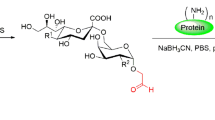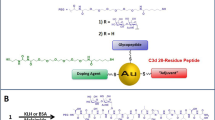Abstract
Mucins of colorectal carcinomas overexpress the cancer-associated disaccharides Thomsen-Friedenreich antigen (TF) and sialyl-Tn antigen (sTn), making these antigens suitable for active specific immunotherapy. Patients at high risk for recurrent colon cancer, but free from disease after surgical resection, were immunized with synthetic TF and sTn covalently attached by a two-carbon crotyl linker to keyhole limpet hemocyanin (KLH). Four groups of patients were treated with TF-KLH without adjuvant, TF-KLH plus the immunological adjuvant Detox, sTn-KLH plus Detox, or sTn-KLH plus the immunological adjuvant QS-21, and the serological response was monitored. Enzyme-linked immunosorbent assay (ELISA), do-blot immunostains, and inhibition assays were used to identify antibody responses against synthetic TF and sTn epitopes and against natural antigens, including asialoglycophorin expressing TF antigen, and ovine submaxillary mucin and the human colon cancer line LS-C expressing sTn antigen. Our results demonstrate that vaccines containing TF or sTn-KLH conjugates plus immunological adjuvants Detox and especially QS-21 induced high IgM and IgG antibody titers against the respective synthetic disaccharide epitopes. However, when tested against natural antigens expressing these disaccharide epitopes, IgM antibodies showed weak to moderate reactivity, while IgG antibodies were almost totally unreactive. On the basis of these results we are continuing to test modifications of synthetic TF and sTn epitopes to identify those that induce IgM and IgG antibodies that are more reactive with these antigens as they are expressed on tumor mucins.
Similar content being viewed by others
References
Borch RF, Berenstein MD, Durst HD (1971) The cyanohydridoborate anion as a selective reducing agent. J Am Chem Soc 93: 2897
Bray J, MacLean, GD, Dusel FJ, McPherson TA (1982) Decreased levels of circulating lytic anti-T in the serum of patients with metastatic gastrointestinal cancer. Clin Exp Immunol 47: 176
Cholcher D, Horan H, Nuti M, Schlom J (1981) A spectrum of monoclonal antibodies reactive with human mammary tumor cells. Proc Natl Acad Sci USA 78: 3199
Ernst CS, Shen JW, Litwin S, Herlyn M, Koprowski H, Sears HF (1986) Multiparameter evaluation of the expressionin situ of normal tumor-associated antigens in human colorectal carcinoma. J Natl Cancer Inst 77: 387
Eskola J, Kayhyty H, Takaia AK Peltola H, Ronnenberg PR, Kha E, Pekkanen E, McVerry PH, Makela PH (1990) A randomized perspective field trial of a conjugate vaccine in the protection of infants and young children against invasiveHaemophilus influenzae type B disease. N Engl J Med 323: 1381
Fung PYS, Madej M, Koganty RR, Longenecker BM (1990) Active specific immunotherapy of a murine mammary adenocarcinoma using a synthetic tumor-associated glycoconjugate. Cancer Res 50: 4308
Gold DV, Mattes MJ (1988) Monoclonal antibody B72.3 reacts with core region structure of O-linked carbohydrates. Tumor Biol 9: 137
Hawkes R, Niday E, Gordon JA (1982) Dot-immunobinding assay for monoclonal and other antibodies. Anal Biochem 119: 142
Helling F, Shang A, Calves M, Zhang S, Ren S, Yu YK, Oettgen HF, Livingston PO (1994) GD3 vaccines for melanoma: superior immunogenicity of KLH conjugate vaccines. Cancer Res 54: 197
Helling F, Zhang S, Shang A, Adluri S, Calves M, Koganty R, Longenecker BM, Tzy-Jyun, Y, Oettgen HF, Livingston PO (1995) GM2-KLH conjugate vaccine: increased immunogenicity in melanoma patients after administration with immunological adjuvant QS-21. Cancer Res (in press)
Itzkowitz S, Yuan M, Montgomery C, Kjeldsen T, Takahashi H, Bigbee W (1989) Expression of Tn, sialosyl-Tn, and T antigens in human colon cancer. Cancer Res 49: 197
Itzkowitz S, Bloom EJ, Kokal WA, Modin G, Hakamori S-I, Kim YS (1990) Sialosyl Tn: a novel mucin antigen associated with prognosis in colorectal carcinoma patients. Cancer 66: 1960
Kjeldsen T, Clausen H, Hirohashi S, Ogawa T, Iijima H, Hakamori S (1988) Preparation and characterization of monoclonal antibodies directed to the tumor-associated O-linked sialosyl-2-6N-acetylgalactosaminyl (sialosyl-Tn) epitope. Cancer Res 48: 2214
Kobayashi H, Toshihiko T, Kawashima Y (1992) Serum sialyl-Tn as an independent predictor of poor prognosis in patients with epithelial ovarian cancer. J Clin Oncol, 10: 95
Livingston PO, Cunningham-Rundles S, Marflet G, Greco C, Wong GY, Schiffman G, Enker WE, Hoffman MK (1987) Inhibition of suppressor cell activity of cyclophosphamide in patients with malignant melanoma. J Biol Response Mod 6: 392
Livingstone PO, Ritter G, Calves MJ (1989) Antibody response after immunization with the gangliosides GM1, GM2, GM3, GD2, and GD3 in the mouse. Cancer Immunol Immunother 29: 179
Livingston PO, Koganty RR, Longenecker BM, Lloyd KO, Calves MJ (1991) Studies on the immunogenicity of synthetic and natural Thomsen-Friedenreich (TF) antigens in mice: augmentation of the response by Quil A and SAF-m adjuvants and analysis of the specificity of the responses. Vaccine Res 1: 99
Livingston PO, Adhuri S, Helling F, Yao T-Y, Kensil CR, Newman M, Marciani D (1994) Phase 1 trial of the immunological adjuvant QS-21 with a GM2 ganglioside-keyhole limpet hemocyanin conjugate vaccine in patients with malignant melanoma. Vaccine 12: 1275
Longenecker BM, Rahman AFR, Barrington LJ, et al (1984) Monoclonal antibody against a cryptic carbohydrate antigen of murine and human lymphocytes. I. Antigen expression in noncryptic or unsubstituted form on certain murine lymphomas, on a spontaneous murine mammary carcinoma, and on several human adenocarcinomas. Int J Cancer 33: 123
MacLean GD, Yacyshyn-Bowen MB, Samuel J, Meikle A, Stuart G, Nation J, Poppema S, Jerry M, Koganty RR, Wong T, Longenecker BM (1992) Active immunization of human ovarian cancer patients against a common carcinoma (Thomsen-Friedenreich) determinant using a synthetic carbohydrate antigen. J Immunother 11: 292
MacLean GD, Reddish M, Koganty RR, Wong T, Gandhi S, Smolenski M, Samuel J, Nabholtz JM, Longenecker BM (1993) Immunization of breast cancer patients using a synthetic sialyl-Tn glycoconjugate plus Detox adjuvant. Cancer Immunol Immunother 36: 215
Minsky BD, Mies C, Rich TA, Recht A, Chaffey JT (1987) Colloid carcinoma of the colon and rectum. Cancer 60: 3101
Nakada H, Inoue M, Numata Y, Tanaka N, Funakoshi I, Fukui S, Mellors A, Yamashima I (1993) Epitopic structure of Tn glycophorin A for an anti-Tn antibody (MLS128). Proc Natl Acad Sci USA 90: 2495
Numata Y, Nakada H, Fukui S, Kitgawa H, Ozaki K, Inoue M, Kawasaki T, Funakoshi I, Yamashima IA (1990) Monoclonal antibody directed to Tn antigen. Biochem Biophys Res Comun 170: 981
O'Boyle K, Zamore R, Adluri S, Cohen A, Kemeny N, Welt S, Lloyd KO, Oettgen HF, Old LF, Livingston PO (1992) Immunization of colorectal cancer patients with modified ovine submaxillary mucin and adjuvants induces IgM and IgG antibodies to sialylated Tn. Cancer Res 52: 5663
Ogata S, Chen A, Itzkowitz SH (1994) Use of model cell lines to study the biosynthesis and biological role of cancer-associated sialosyl-Tn antigen. Cancer Res 54: 4036
Raff HV, Bradley C, Brady W, Donaldson K, Lipsich L, Maloney G, Shuford W, Walls M, Ward P, Wolff E, Harris LJ (1991) Comparison of functional activities between IgG1 and IgM class-switched human monoclonal antibodies reactive with group B streptococci orEscherichia coli K1. J Infect Dis 163: 346
Rahman AFR, Longenecker BM (1982) A monoclonal antibody specific for the Thomsen-Friedenreich cryptic T antigen. J Immunol 129: 2021
Springer GF (1984) T and Tn, general carcinoma autoantigens. Science 224: 1198
Springer GF (1989) Tn epitope (N-acetyl-d-galactosamine-O-serine/threonine) density in primary breast cancer: a functional predictor of aggresiveness. Mol Immunol 26: 1
Springer GF, Desai PR (1974) Common precursors of human blood group MN specificities. Biochem Biophys Res Commun 61: 470
Stein R, Goldenberg DM, Mattes MJ (1991) Normal tissue reactivity of four anti-tumor monoclonal antibodies of clinical interest. Int J Cancer 47: 163
Svennerholm L (1963) Chromatographic separation of human brain gangliosides. J Neurochem 10: 613
Thor A, Ohuchi N, Szpak CA, Johnston WW, Schlom J (1986) The distribution of oncofetal antigen TAG-72 defined by monoclonal antibody B72.3. Cancer Res 46: 3118
Zhang S, Walberg LA, Ogata S, Itzkowitz S, Koganty RR, Reddish M, Gandhi SS, Longenecker BM, Lloyd KO, Livingston PO (1995) Immune sera and monoclonal antibodies define two configurations for the sialyl Tn tumor antigen. Cancer Res (in press)
Author information
Authors and Affiliations
Additional information
This work was supported by grants from the National Institutes of Health (CA33049, CA52491, CA08748) and the Chemotherapy Foundation
Rights and permissions
About this article
Cite this article
Adluri, S., Helling, F., Ogata, S. et al. Immunogenicity of synthetic TF-KLH (keyhole limpet hemocyanin) and sTn-KLH conjugates in colorectal carcinoma patients. Cancer Immunol Immunother 41, 185–192 (1995). https://doi.org/10.1007/BF01521345
Received:
Accepted:
Issue Date:
DOI: https://doi.org/10.1007/BF01521345




